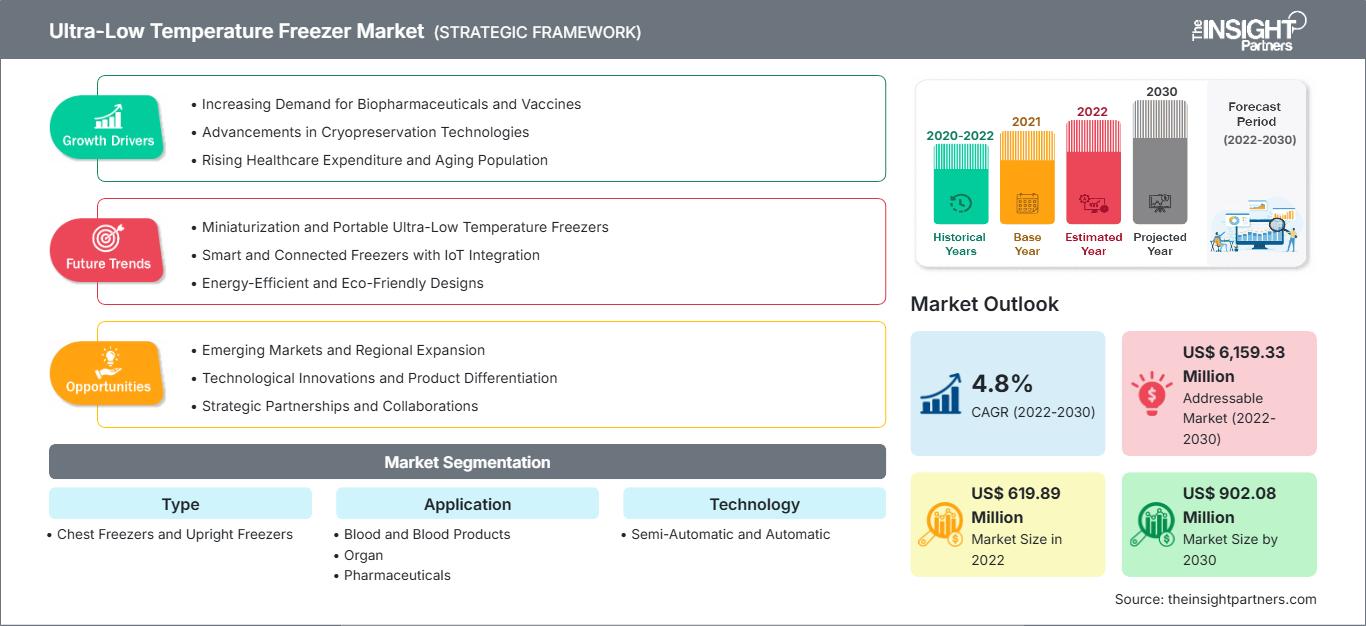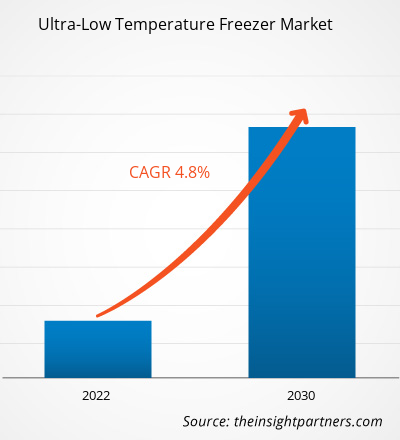[Rapporto di ricerca] Si prevede che il mercato dei congelatori a bassissima temperatura crescerà da 619,89 milioni di dollari nel 2022 a 902,08 milioni di dollari entro il 2030; si prevede che registrerà un CAGR del 4,8% dal 2022 al 2030.
Approfondimenti di mercato e punto di vista degli analisti:
Le dimensioni del mercato dei congelatori a bassissima temperatura si stanno espandendo con le crescenti attività di ricerca e sviluppo per introdurre nuovi composti farmacologici, la crescente domanda di sangue e componenti del sangue e il crescente sostegno governativo alle attività di ricerca e alle sperimentazioni cliniche. Inoltre, la disponibilità di prodotti avanzati da parte degli operatori del mercato guida la crescita del mercato. I congelatori verticali Thermo Scientific Revco RLE -86°C sono disponibili in cinque capacità, con una capacità di 300 fino a 700 scatole da 2 pollici. Questi congelatori offrono prestazioni termiche, sicurezza e protezione eccezionali.
Fattori di crescita e sfide:
I campioni di ricerca biologica devono essere conservati a temperature inferiori a -80 °C, ovvero a temperature ultra basse (ULT). La tecnologia ULT offre un'alternativa alla tecnologia di raffreddamento standard basata su compressore, che continua a migliorare con la crescente comprensione del suo funzionamento. I prodotti innovativi offerti da Haier Biomedical includono congelatori ULT con tecnologia di conversione di frequenza intelligente che vantano un consumo energetico senza pari di soli 8,2 kWh/giorno con una capacità unitaria di 829 l/29,2 piedi cubi. Nell'ottobre 2022, Thermo Fisher Scientific ha lanciato un nuovo congelatore nel suo portafoglio ecologico a temperature ultra basse (ULT), il congelatore orizzontale Thermo Scientific TDE Series -80 °C. Il congelatore è alimentato da sistemi a idrocarburi H-drive e migliora le prestazioni richieste per la ricerca fondamentale senza compromettere gli obiettivi di sostenibilità. Nel giugno 2023, il congelatore verticale ultrafreddo Stirling ULT classe ISO 6 di BioLife Solutions è stato approvato per applicazioni in camera bianca in conformità alle Norme di Buona Fabbricazione (GMP), senza compromettere le prestazioni di bioconservazione o la pulizia dell'ambiente. I congelatori per la conservazione di campioni ULT sono una componente fondamentale di molte biobanche, cliniche e laboratori in tutto il mondo. Queste unità consentono di conservare un'ampia varietà di campioni biologici, inclusi DNA, RNA, proteine ed estratti cellulari. È necessaria un'alimentazione elettrica costante per mantenere bassi i livelli di temperatura. L'International Institute for Sustainable Laboratories ha affermato che un congelatore ULT medio consuma la stessa quantità di energia, 20 kWh al giorno, di un'abitazione unifamiliare. Considerando che laboratori e centri di ricerca solitamente gestiscono decine di queste unità contemporaneamente, i costi operativi ed energetici possono influenzare le preferenze dell'utente. Il costo medio di gestione di un congelatore a bassissima temperatura verticale (ULT) può variare da 750 dollari (570 sterline) a 1.000 dollari (750 sterline) all'anno, a seconda di diversi fattori come le dimensioni e l'intervallo di temperatura. Una manutenzione regolare e lo sbrinamento possono ridurre notevolmente questo costo. Inoltre, le cifre sopra menzionate relative ai congelatori a bassissima temperatura non considerano i costi aggiuntivi dei sistemi HVAC e di rimozione dell'aria calda. Pertanto, gli elevati costi associati ai congelatori a bassissima temperatura diventano un problema serio per i laboratori e i magazzini con budget limitato.
Personalizza questo rapporto in base alle tue esigenze
Potrai personalizzare gratuitamente qualsiasi rapporto, comprese parti di questo rapporto, o analisi a livello di paese, pacchetto dati Excel, oltre a usufruire di grandi offerte e sconti per start-up e università
Mercato dei congelatori a bassissima temperatura: Approfondimenti strategici

-
Ottieni le principali tendenze chiave del mercato di questo rapporto.Questo campione GRATUITO includerà l'analisi dei dati, che vanno dalle tendenze di mercato alle stime e alle previsioni.
Segmentazione e ambito del rapporto:
Il mercato dei congelatori a bassissima temperatura è segmentato in base a tipologia, applicazione, tecnologia e area geografica. Il mercato dei congelatori a bassissima temperatura è segmentato in base a tipologia, applicazione, tecnologia e area geografica. Il mercato dei congelatori a bassissima temperatura, per applicazione, è segmentato in sangue e prodotti ematici, organi, prodotti farmaceutici, ricerca forense e genomica e altri. Il mercato, per tecnologia, è suddiviso in automatico e semiautomatico.
In base all'area geografica, il mercato dei congelatori a bassissima temperatura è segmentato in Nord America (Stati Uniti, Canada e Messico), Europa (Regno Unito, Germania, Francia, Italia, Spagna, Russia e resto d'Europa), Asia-Pacifico (Cina, Giappone, India, Corea del Sud, Australia, Sud-est asiatico e resto dell'Asia-Pacifico), Medio Oriente e Africa. Africa (Emirati Arabi Uniti, Arabia Saudita, Sudafrica e resto del Medio Oriente e Africa) e America Meridionale e Centrale (Brasile, Argentina e resto dell'America Meridionale e Centrale).
Analisi Segmentale:
Il mercato dei congelatori a bassissima temperatura, per tipologia, è suddiviso in congelatori orizzontali e congelatori verticali. Nel 2022, il segmento dei congelatori verticali ha detenuto una quota di mercato maggiore e si prevede che lo stesso segmento registrerà un CAGR più elevato tra il 2022 e il 2030. La crescita di mercato prevista per il segmento dei congelatori verticali è attribuita a vantaggi quali il design compatto, la facilità di organizzazione e la disponibilità di diverse funzioni di sicurezza. Inoltre, l'aumento del tasso di adozione dovuto ai progressi tecnologici che portano a una migliore supervisione delle operazioni e alla facilità d'uso aumenterebbe la crescita del mercato dei congelatori a bassissima temperatura per il segmento verticale durante il periodo di previsione.
Analisi regionale:
In base all'area geografica, il mercato dei congelatori a bassissima temperatura è segmentato in Nord America, Europa, Asia-Pacifico, Medio Oriente e Africa e America meridionale e centrale. Il Nord America contribuisce maggiormente alla crescita del mercato globale dei congelatori a bassissima temperatura. Si prevede che l'Asia-Pacifico registrerà il CAGR più elevato nel mercato dei congelatori a bassissima temperatura tra il 2022 e il 2030. La crescita del mercato dei congelatori a bassissima temperatura negli Stati Uniti è trainata principalmente dalla crescente prevalenza del cancro ai polmoni, dal lancio di nuovi prodotti e dalle iniziative governative. La crescente domanda di biobanche apporta un potenziale trasformativo ai sistemi sanitari ed economici degli Stati Uniti. Tuttavia, l'attenzione immediata alle biobanche in rapido sviluppo nel Paese è rafforzata dalla necessità di comprendere le malattie, scoprire nuovi farmaci e svilupparli. Inoltre, la ricerca sulle biobanche fornisce nuove informazioni sulla componente genetica delle malattie umane, concentrandosi sullo sviluppo di un approccio all'assistenza sanitaria automatizzato e più personalizzato. Inoltre, diversi operatori del mercato negli Stati Uniti si concentrano sull'offerta di un portafoglio diversificato e all'avanguardia di prodotti e servizi di biobanche progettati per accelerare le scoperte salvavita. Il crescente numero di attività commerciali tra gli operatori del mercato sta contribuendo dinamicamente alla crescita del mercato. A novembre 2020, gli ospedali negli stati e nelle città degli Stati Uniti hanno avuto difficoltà ad acquistare congelatori ultra-freddi in grado di conservare in sicurezza il vaccino PFE.N COVID-19 di Pfizer Inc, ignorando il consiglio dei Centri per il Controllo e la Prevenzione delle Malattie (CDC) statunitensi di rimandare.
Mercato dei congelatori a bassissima temperaturaLe tendenze regionali e i fattori che influenzano il mercato dei congelatori a bassissima temperatura durante il periodo di previsione sono stati ampiamente spiegati dagli analisti di The Insight Partners. Questa sezione illustra anche i segmenti e la geografia del mercato dei congelatori a bassissima temperatura in Nord America, Europa, Asia-Pacifico, Medio Oriente e Africa, America Meridionale e Centrale.
Ambito del rapporto di mercato dei congelatori a bassissima temperatura
| Attributo del rapporto | Dettagli |
|---|---|
| Dimensioni del mercato in 2022 | US$ 619.89 Million |
| Dimensioni del mercato per 2030 | US$ 902.08 Million |
| CAGR globale (2022 - 2030) | 4.8% |
| Dati storici | 2020-2022 |
| Periodo di previsione | 2022-2030 |
| Segmenti coperti |
By Tipo
|
| Regioni e paesi coperti |
Nord America
|
| Leader di mercato e profili aziendali chiave |
|
Densità degli operatori del mercato dei congelatori a bassissima temperatura: comprendere il suo impatto sulle dinamiche aziendali
Il mercato dei congelatori a bassissima temperatura è in rapida crescita, trainato dalla crescente domanda degli utenti finali, dovuta a fattori quali l'evoluzione delle preferenze dei consumatori, i progressi tecnologici e una maggiore consapevolezza dei vantaggi del prodotto. Con l'aumento della domanda, le aziende stanno ampliando la propria offerta, innovando per soddisfare le esigenze dei consumatori e sfruttando le tendenze emergenti, alimentando ulteriormente la crescita del mercato.

- Ottieni il Mercato dei congelatori a bassissima temperatura Panoramica dei principali attori chiave
Sviluppi del settore e opportunità future:
Di seguito sono elencate diverse iniziative dei principali attori che operano nel mercato dei congelatori a bassissima temperatura:
- A maggio 2023, PHC Corporation of North America (PHCNA) ha annunciato che il congelatore a bassissima temperatura VIP ECO SMART del marchio PHCbi ha ricevuto il prestigioso Outstanding New Product Award per il 2023 dall'International Society for Biological and Environmental Repositories (ISBER). Il prodotto è progettato per l'uso in una vasta gamma di strutture come università, istituti medici e aziende farmaceutiche.
- A febbraio 2023, PHC Corporation of North America (PHCNA) ha lanciato la serie di congelatori a bassissima temperatura VIP ECO SMART del marchio PHCbi. Questa nuova serie si basa su congelatori a bassissima temperatura innovativi e affidabili per offrire prestazioni di risparmio energetico ottimizzate, migliorando al contempo sicurezza e usabilità.
Panorama competitivo e aziende chiave:
Thermo Fisher Scientific Inc, Godrej Group, Haier Group Corporation, Blue Star Limited, Helmer Scientific Inc, PHC Holdings, BioLife Solutions Inc, Eppendorf SE, Meling Biomedical e Arctiko sono tra i principali attori che operano nel mercato dei congelatori a bassissima temperatura. Queste aziende si concentrano sul lancio di nuovi prodotti e sull'espansione geografica per soddisfare la crescente domanda dei consumatori in tutto il mondo e ampliare la propria gamma di prodotti nei portafogli specializzati. La loro presenza globale consente loro di servire un'ampia base di clienti, facilitando di conseguenza l'espansione del mercato.
- Analisi storica (2 anni), anno base, previsione (7 anni) con CAGR
- Analisi PEST e SWOT
- Valore/volume delle dimensioni del mercato - Globale, Regionale, Nazionale
- Industria e panorama competitivo
- Set di dati Excel
Report recenti
Rapporti correlati
Testimonianze
Motivo dell'acquisto
- Processo decisionale informato
- Comprensione delle dinamiche di mercato
- Analisi competitiva
- Analisi dei clienti
- Previsioni di mercato
- Mitigazione del rischio
- Pianificazione strategica
- Giustificazione degli investimenti
- Identificazione dei mercati emergenti
- Miglioramento delle strategie di marketing
- Aumento dell'efficienza operativa
- Allineamento alle tendenze normative






















 Ottieni un campione gratuito per - Mercato dei congelatori a bassissima temperatura
Ottieni un campione gratuito per - Mercato dei congelatori a bassissima temperatura